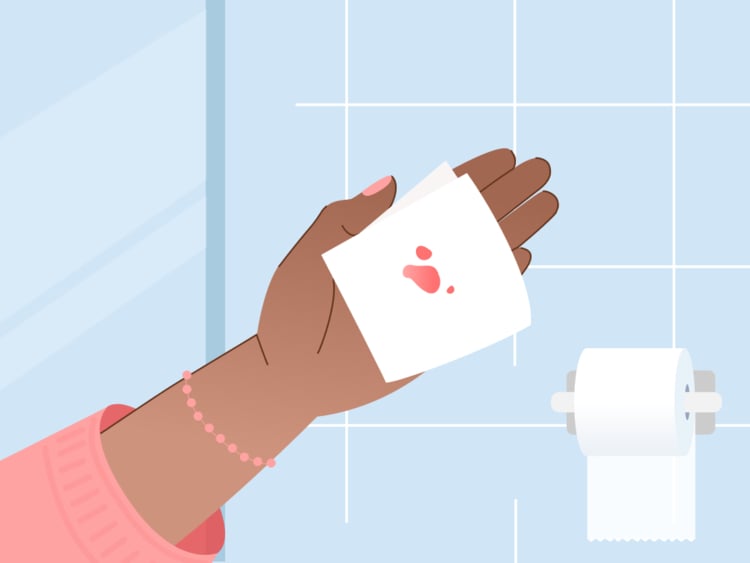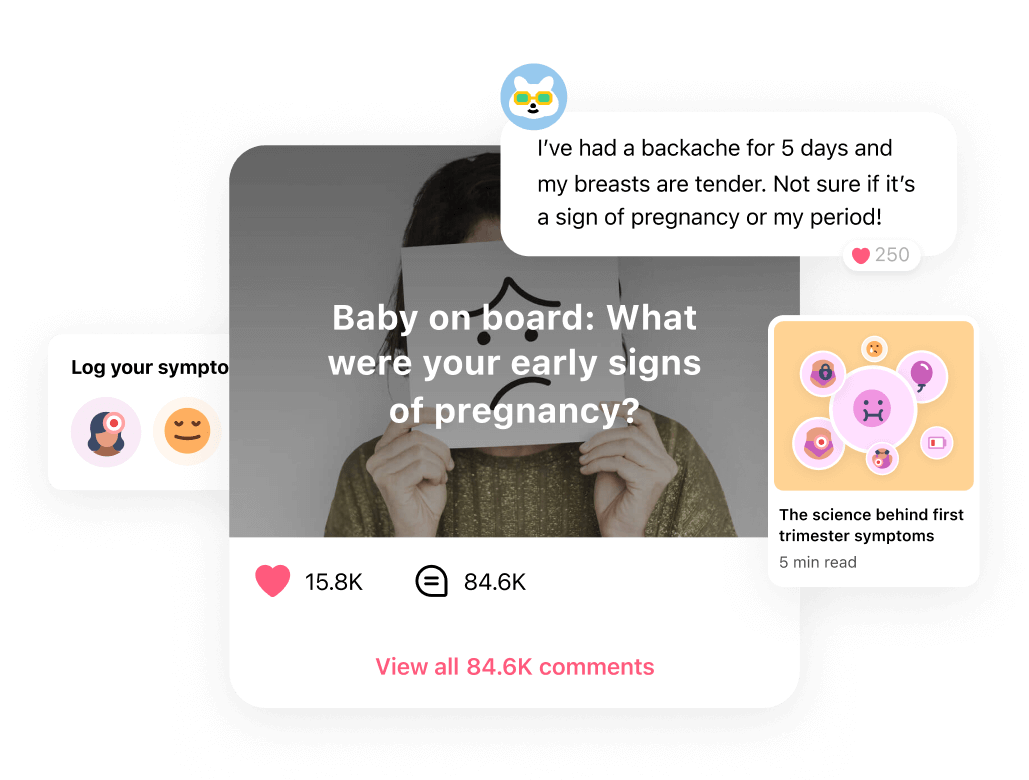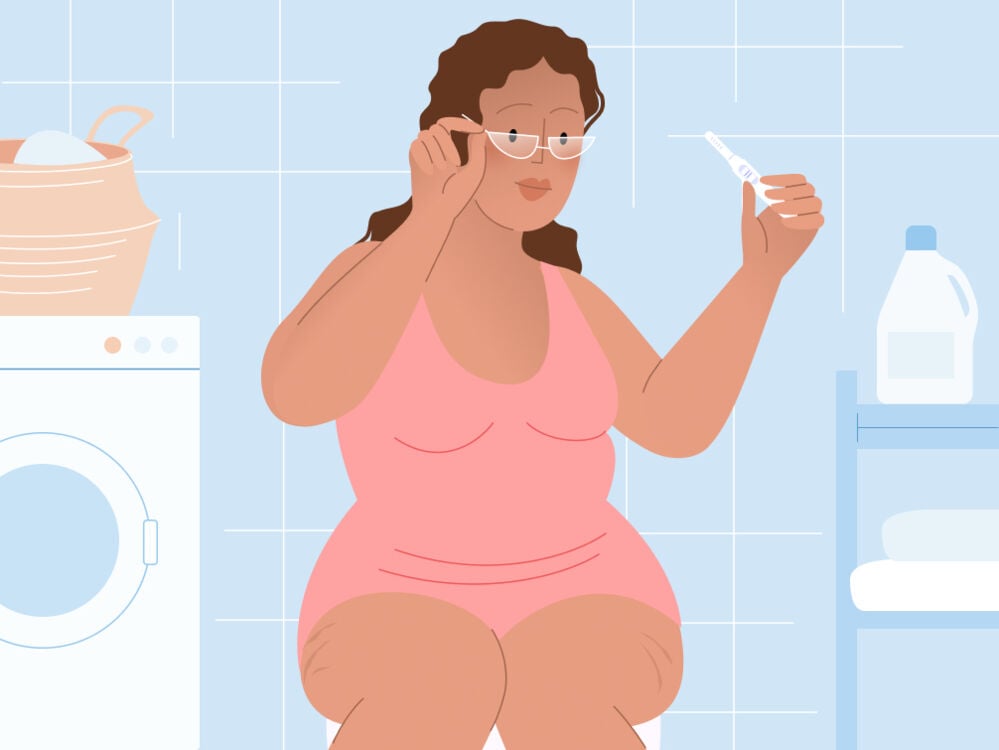You’ve spotted blood in your underwear, but is it implantation bleeding or your normal monthly period? While these types of bleeding are similar, there are a few differences to look out for, as a doctor explains.
-
Tracking cycle
-
Getting pregnant
-
Pregnancy
-
Help Center
-
Flo for Partners
-
Anonymous Mode
-
Flo app reviews
-
Flo Premium New
-
Secret Chats New
-
Symptom Checker New
-
Your cycle
-
Health 360°
-
Getting pregnant
-
Pregnancy
-
Being a mom
-
LGBTQ+
-
Quizzes
-
Ovulation calculator
-
hCG calculator
-
Pregnancy test calculator
-
Menstrual cycle calculator
-
Period calculator
-
Implantation calculator
-
Pregnancy weeks to months calculator
-
Pregnancy due date calculator
-
IVF and FET due date calculator
-
Due date calculator by ultrasound
-
Medical Affairs
-
Science & Research
-
Pass It On Project New
-
Privacy Portal
-
Press Center
-
Flo Accuracy
-
Careers
-
Contact Us
Implantation bleeding vs. period bleeding: How can you spot the difference?


Every piece of content at Flo Health adheres to the highest editorial standards for language, style, and medical accuracy. To learn what we do to deliver the best health and lifestyle insights to you, check out our content review principles.
Whether you’re fertility tracking in the hope of conceiving or trying to avoid getting pregnant, seeing blood around the time that your period is due can be a bit of a minefield. That’s because it can be undeniably tricky to figure out whether you’re experiencing implantation bleeding vs. period bleeding. After all, they can both happen at around the same time. Confusing, huh?
That’s why we’ve put together this useful guide to help you differentiate between the two. Keep reading to find out all there is to know about them.

 Over
7.8M
ratings averaging
4.8/5
*
Over
7.8M
ratings averaging
4.8/5
*
Understand your body’s signals with the Flo app
- Chat with others who are trying to get pregnant.
- Get trusted information on signs of pregnancy from 100+ medical experts.
- Log your symptoms and learn what they could be trying to tell you.
 Over
7.8M
ratings averaging
4.8/5
*
Over
7.8M
ratings averaging
4.8/5
*

Trying to conceive?
The Flo app can help you through the two-week wait.

 Over
7.8M
ratings averaging
4.8/5
*
Over
7.8M
ratings averaging
4.8/5
*
Understand your body’s signals with the Flo app
- Chat with others who are trying to get pregnant.
- Get trusted information on signs of pregnancy from 100+ medical experts.
- Log your symptoms and learn what they could be trying to tell you.
Signs of implantation bleeding
Implantation bleeding is light spotting that usually appears at around the time you’d normally have your period. Of course it does, just to add to the confusion. It can be one of the early signs of pregnancy and usually begins around 10 to 14 days after conception.
But what actually is implantation, and why can it make some people bleed? “Implantation bleeding refers to bleeding that happens around the time that the fertilized egg burrows into the uterine lining. This bleeding is typically light or just spotting, and it isn’t associated with pain,” says Dr. Jennifer Boyle, obstetrician and gynecologist, Massachusetts, US.
Although experts describe implantation bleeding as common, it’s difficult to pinpoint exactly how many people will experience it, and some won’t have any bleeding at all. So if you’re hoping to get pregnant but you haven’t seen any spots of blood around two weeks after ovulation, it doesn’t necessarily mean it’s bad news. “We don’t know why some women experience it and others don’t,” adds Dr. Boyle.
On the other hand, also try not to panic if you do experience bleeding early in your pregnancy, as it can be very common. Research shows that 15% to 25% of women experience some sort of bleeding during their first trimester.
So how long does implantation bleeding last, and what should you expect it to look like? “Implantation bleeding may only be noticed once or a few times in a single day and certainly shouldn’t last more than 2 to 3 days at the very most,” explains Dr. Boyle. So that might help you distinguish it from a period. In terms of color, implantation bleeding can range from pink or red to brown (just like a period can).
Take a quiz
Find out what you can do with our Health Assistant
Other signs of pregnancy
As we’ve mentioned, implantation bleeding isn’t usually associated with any pain, but there are some other common early signs of pregnancy that you can look out for if you’re starting to suspect you might have conceived. These include:
- Nausea and vomiting
- Needing to pee more often
- Tiredness
- Sore breasts
- Food cravings and aversions
- Cramps
- Vaginal discharge
- Mood swings
- Constipation and bloating
Signs of period bleeding
Now that we’ve taken a look at implantation bleeding, let’s move on to periods. A period happens roughly every 28 days, but anything from 21 to 35 days is considered normal for a menstrual cycle. “Period bleeding tends to start light, then gets heavier with more cramping, and then gets light again,” explains Dr. Boyle. The bleeding typically lasts between two to seven days, and the color of your period can range from red, when your flow is heaviest, to brown, when it’s lighter. So as you can see, the bleeding pattern for a period is really quite different from implantation bleeding.
Other signs of a period
Of course, you’re likely to experience other symptoms during your period, and they might also help you to tell whether it’s just your regular cycle you’re experiencing. Some of the signs of your period include:
- Menstrual cramps — this is the pain you feel in your lower abdomen in the days leading up to your period or during your period. And most of us have been there; the American College of Obstetricians and Gynecologists says that this affects more than half of women who menstruate.
- Food cravings — the hormones estradiol (a form of estrogen) and progesterone have been found to cause food cravings during the menstrual cycle, making your monthly ice cream obsession reassuringly normal. One study linked estradiol to increased carb consumption and progesterone to a liking for sweet drinks.
- PMS — this is also an extremely common condition, estimated to affect 3 out of 4 menstruating people. If you have it, you could be saddled with mood swings, fatigue, a low sex drive, bloating, and acne.
Are you interested in learning even more about your period? You can test your knowledge with Flo’s period quiz.
How do you know if it’s implantation bleeding or your period?
This is the clincher, as both types of bleeding obviously mean very different things. If you want to get an idea of whether or not you’re pregnant and you’re yet to take a pregnancy test, it can be handy to differentiate between implantation bleeding vs. period bleeding. Let us help …
Similar signs between implantation and period bleeding
It’s safe to say you won’t be the only one who’s ever been confused about whether the spots of blood in your underwear are due to implantation bleeding or the start of your period. And fundamentally, as we now know, that’s because they happen around the same time. This can be a particularly bewildering time for anyone who’s used to having light periods, because of the light blood flow associated with implantation bleeding. But this is pretty much where the similarities end in terms of the bleeding itself.
However, as we’ve seen above, there are a number of other similarities between the symptoms of a period and the early symptoms of pregnancy, which can mean it’s easy to mistake a period for being pregnant or the other way around. As a quick recap, these can include:
- Cramps
- Mood swings
- Food cravings
- Sore breasts
- Fatigue
- Constipation
If you’re experiencing any of these symptoms, the only real way to confirm whether they’re due to PMS or pregnancy is to take a pregnancy test. We share more on when you should do that below.
Differences between implantation and period bleeding
There are two key differences that can help you to distinguish between implantation bleeding vs. period bleeding. First, periods typically last longer (between 2 to 7 days) than implantation bleeding. Remember, as Dr. Boyle mentioned above, implantation bleeding generally only spans two to three days at the most.
The amount of blood is also important to take note of. While implantation bleeding tends to cause a minimal amount of light spotting, the average person loses around 30 to 72 ml — or 5 to 12 teaspoons — of blood during their period. This means, for example, that you wouldn’t soak up a pad or a tampon if you were having an implantation bleed, whereas you could if you were having a period. It’s also useful to mention here that period blood clots, which you might see on a pad, a tissue, or in the toilet, are also a sign that you’re having a period and not an implantation bleed.
When might it be a good idea to take a pregnancy test?
If you’ve read all this, but you’re still not sure what’s to blame for the blood in your underwear, there’s probably only one thing for it: take a pregnancy test. But when exactly? To make sure your pregnancy test is as accurate as possible, it’s advised that you wait until after the first day of your missed period. This is because your body needs time to produce the pregnancy hormone called human chorionic gonadotropin (hCG). This doesn’t start happening until after implantation, and the levels then need to build up so they’re high enough to be detected in your urine when you pee on the stick.
If you’re somebody who doesn’t have regular periods, this understandably won’t be as straightforward. But don’t fret — if you wait at least 21 days from the time you had sex, your hCG levels should be high enough to register on a pregnancy test. If you want to figure out the best time to take a pregnancy test, you can give Flo’s online pregnancy test calculator a try.
Hopefully, waiting long enough will also stop you from having to buy unnecessary pregnancy tests — those costs can certainly add up!

When should you see a doctor?
This totally depends on what you conclude. If you decide your bleeding is, in fact, just your period, then there’s probably no need to see a doctor (unless you notice anything that’s abnormal for you, of course, in which case you should always get checked out). If you’ve been trying for a while to get pregnant and haven’t had any luck, it’s definitely worth having a chat with a health care professional. Book a fertility checkup if you’ve been trying to conceive for a year and you’re under 35, 6 months if you’re over 35, or immediately if you’re 40 or above.
If you’ve taken a pregnancy test and it’s come back positive, now is the time to reach out to your doctor, who will help you arrange your first prenatal visit. This will happen in your first trimester, as your health care provider will want to know all the ins and outs regarding your health and will share any advice on having a healthy pregnancy.
According to Johns Hopkins University, this first prenatal visit is the most detailed, and you should also expect a physical exam along with a series of tests. These include blood and possibly genetic tests, as well as a urine sample. Most exciting of all, they’ll need to know the date of the first day of your last period so that they can calculate your due date!
As we’ve seen, light implantation bleeding is common in pregnancy and nothing to worry about. However, speak to your doctor if you experience any heavier bleeding. “Any bleeding that is heavy, painful, or lasts for more than 2 to 3 days is a reason to see your doctor,” says Dr. Boyle. “Remember that bleeding in early pregnancy can, rarely, be a sign of an ectopic or tubal pregnancy, and this can be life-threatening. Heavy bleeding can also be a sign of a miscarriage.” Try not to panic if you do experience heavy bleeding; see your doctor as soon as possible, and hopefully, they can reassure you.
Implantation bleeding vs. period bleeding: The takeaway
Considering the huge amount of similarities between implantation bleeding vs period bleeding, you wouldn’t be blamed for mistaking one for the other. You might find this a little frustrating, especially if you’re trying to get pregnant and are feeling impatient about finding out whether you’re pregnant or not.
Luckily, once you’re able to understand the differences between the two, it’ll be easier for you to identify what’s going on with your body. And don’t forget, as long as it’s not too early to take one, you can use a pregnancy test, as long as the instructions are followed correctly.


Hey, I'm Anique
I started using Flo app to track my period and ovulation because we wanted to have a baby.


The Flo app helped me learn about my body and spot ovulation signs during our conception journey.


I vividly
remember the day
that we switched
Flo into
Pregnancy Mode — it was
such a special
moment.
Real stories, real results
Learn how the Flo app became an amazing cheerleader for us on our conception journey.
References
“Bleeding during Pregnancy.” The American College of Obstetricians and Gynecologists, www.acog.org/womens-health/faqs/bleeding-during-pregnancy. Accessed 6 Dec. 2022.
“Dysmenorrhea: Painful Periods.” The American College of Obstetricians and Gynecologists, www.acog.org/womens-health/faqs/dysmenorrhea-painful-periods. Accessed 7 Dec. 2022.
“Home Pregnancy Tests: Can You Trust the Results?” Mayo Clinic, 24 Feb. 2021, www.mayoclinic.org/healthy-lifestyle/getting-pregnant/in-depth/home-pregnancy-tests/art-20047940.
“Implantation Bleeding: Common in Early Pregnancy?” Mayo Clinic, 19 Apr. 2022, www.mayoclinic.org/healthy-lifestyle/pregnancy-week-by-week/expert-answers/implantation-bleeding/faq-20058257.
Krishnan, Sridevi, et al. “Structural Equation Modeling of Food Craving across the Menstrual Cycle Using Behavioral, Neuroendocrine, and Metabolic Factors.” Physiology & Behavior, vol. 195, Oct. 2018, pp. 28–36.
“Menstrual Cramps.” Mayo Clinic, 30 Apr. 2022, www.mayoclinic.org/diseases-conditions/menstrual-cramps/symptoms-causes/syc-20374938.
“Prenatal Care: 1st Trimester Visits.” Mayo Clinic, 6 Aug. 2022, www.mayoclinic.org/healthy-lifestyle/pregnancy-week-by-week/in-depth/prenatal-care/art-20044882.
“Premenstrual Syndrome (PMS).” Mayo Clinic, 25 Feb. 2022, www.mayoclinic.org/diseases-conditions/premenstrual-syndrome/symptoms-causes/syc-20376780.
“Spotting during Early Pregnancy.” HSE, www2.hse.ie/conditions/spotting/. Accessed 7 Dec. 2022.
“The First Trimester.” 8 Aug. 2021, Johns Hopkins Medicine, www.hopkinsmedicine.org/health/wellness-and-prevention/the-first-trimester.
“Periods.” NHS, 18 Nov. 2021, www.nhs.uk/conditions/periods/.
“Doing a Pregnancy Test.” NHS, www.nhs.uk/pregnancy/trying-for-a-baby/doing-a-pregnancy-test/. Accessed 7 Dec. 2022.
Zanotti, Salena. “Period Blood Clots: Are They Normal?” Cleveland Clinic, 20 Sep. 2021, health.clevelandclinic.org/period-blood-clots-are-they-normal/.
History of updates
Current version (16 January 2023)
Published (17 January 2023)
In this article

Get your personal guide to fertility
-
Learn how to read your body's ovulation signals
-
Find daily conception tips from our experts
-
Chat with others who are trying to get pregnant




